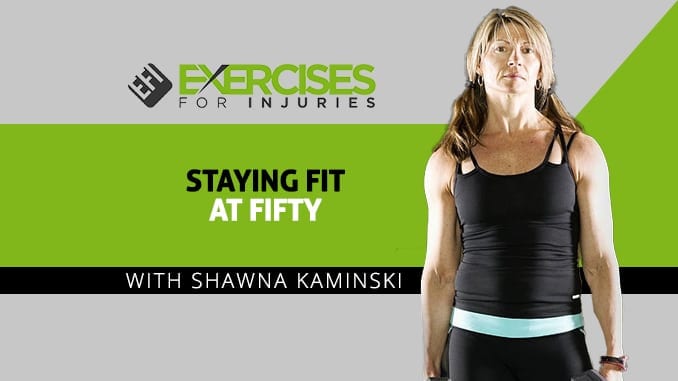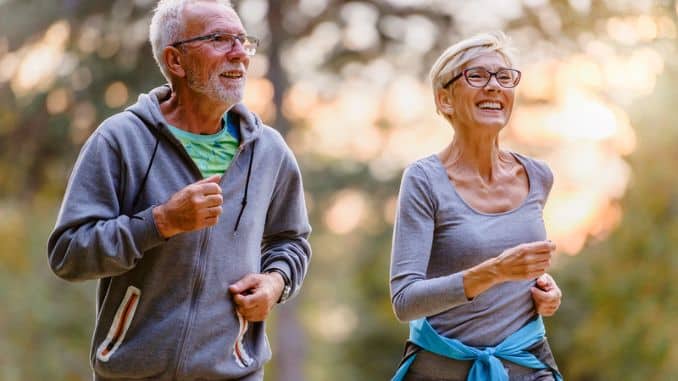
As long as you proceed with caution and avoid overstraining yourself, there are plenty of ways to stay fit at fifty while protecting your body against the natural effects of aging.
I am on the road again, and I am in San Diego at a Fitness Mastermind meeting, and one of the members is Shawna Kaminski, a fellow Canadian from Calgary.
Before the meeting started, we chatted about the secrets to being fit at fifty. I am approaching 40 and want to stay active and increase my fitness with age. I was chatting with Shawna about what I can do to stay as fit as she is fifty.
Shawna, can you share a couple of your secrets with us?
Shawna Kaminski: Well, I think the biggest thing is people use age as an excuse, and they say, “you know what? I am 38, and I shouldn’t be able to do that,” or “I am turning 40, and I shouldn’t be doing that.” The whole thing is we shouldn’t back off intensity.
If you are turning 50 and haven’t done anything, you can’t start with super intense workouts. You have to kind of ease into things.
The Biggest Problem I Find
The biggest problem I find with people is that they say, “I turn 40, and my metabolism has tanked.” Well, it is not your metabolism has tanked; over time, you trade fat for muscle because you become more sedentary.
Everyone becomes sedentary, and they don’t mean to, but they slow down as they age or their children get older. If they have kids and children get older, you are not chasing them as much, you are sitting more, and most people have a natural slowdown.
In their daily life, they are not as active, and then they find ways not to be as intense in their workouts, which is intentional. And they use age as an excuse for it, which it really shouldn’t be.
Trading fat for muscle [¹], being sedentary, metabolism doesn’t tank so much, and our muscle is metabolically active. And so the muscles you have, your metabolism will stay pumped up.
Muscle Mass
The key is maintaining your lean muscle tone, and I am talking about muscle mass.
You don’t need to go and get huge. Just maintain the muscle that you have built.
My goal is I am trying to build more muscles. I am not going to build tons of muscles. I maintain what I have, so those muscles help maintain my metabolism.
Another thing is doing short workouts using cardio. So many people think they need to run and get on the treadmill. If you like running for mental health or you love marathons, great! But you will not get the body of your dreams by running. You cannot get super lean; you will maybe get a skinnier version of yourself, a skinny fat, but you will not get the shaping muscle you are hoping for.

If you want to run, that’s fine, but you need to do burst training with some strength training. When I look back on it, I am a mom, a teacher for 20 years, and now a fitness professional with several businesses; I don’t have much time, but I train every day with very short workouts.
Staying Fit At Fifty
So what do I do? This is what I do, short burst training and strength training. When it comes to my training, I am trying to do heavy bodyweight training, pull-ups, and push-ups, which people see as “oh, that’s just bodyweight.” Well, you can’t change your body weight when you get tired. Looking back, that’s what I’ve been doing, and it is working.
Rick Kaselj: Yes, it is working. Other things that I have noticed when I go to the gym, I am 40, and I see people that are 20; I know when it comes to learning a new exercise or compound movement, I need to go at things a little bit slower. I can’t rush my body like I did when I was 20.
I need to be a little bit smarter at being good with my body because if I tweak it or tweak my back, it can probably throw my workout for a good week, so I need to be a little bit slower and smarter when it comes to doing my workouts to make sure that I have good movements and am not going to injure myself.
Second Thing I Found Out
The second thing I learned is that working with other people pushes your intensity. I think there’s research to back it up that when you train yourself, you go to a certain intensity with the average person, but when you train with others, it will kind of push you out of that comfort zone and into that higher intensity.
You have to think about it; if you are not pushing yourself hard enough, try to train with someone else or another group. Maybe once a week or every month, train with another person or group to push you out of your comfort zone and do different exercises.
Shawna Kaminski: The key to that is the balance between training smartly because we want to push ourselves. You have the energy of the group, and there might be some people who haven’t sprinted since junior high, and they go with it; I say to them to go easy, make modifications, and just build on it. I also use that in my training boot camps, telling my new clients, “50% today,” you will be sore anyway.
We say it is a Marathon; it is not a sprint regarding training. And, of course, it’s all backed by sensible eating. I don’t starve myself; I eat solid nutrition. It’s not a 10,000-hour rule. It is like, “I am not on a diet this week.” This is how I live. I am pleasantly surprised when people say, “are you getting ready for a contest?” or “did you just finish some physique contest?” Yes, in 1990. I competed like a hundred years ago.
Those Are My Secret To Staying Fit At Fifty
But it is just because I am not on a contest diet, but it is just sensible eating. I am not starving myself. I am just making healthy choices [²] 80% of the time. Those are my secrets.
Rick Kaselj: Awesome. There you go, thank you very much, Shawna, and thank you very much, exercisesforinjuries.com readers, listeners, and viewers. Here’s another interview for you, and if you want more information on the injury site of things, swing by exercisesforinjuries.com; it is a resource for exercises and injuries.
If you watch this on YouTube, go above and subscribe to this. And also, definitely check out Shawna’s newest program, Challenge Fat Loss. It’s an amazing workout program. I have a link down below to it.
References
1. Jeukendrup, A. E. (2002). Regulation of Fat Metabolism in Skeletal Muscle. Annals of the New York Academy of Sciences, 967(1), 217–235. https://doi.org/10.1111/j.1749-6632.2002.tb04278.x
2. Koelen, M. A., & Lindström, B. (2005). Making healthy choices easy choices: the role of empowerment. European Journal of Clinical Nutrition, 59(S1), S10–S16. https://doi.org/10.1038/sj.ejcn.1602168

